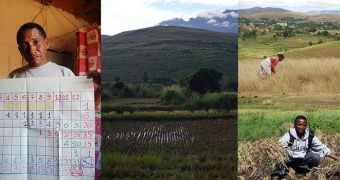For many people in Africa and in the world's poorest regions, rice is the main staple food. But ensuring that production rates keep up with population growth is a challenge. A WWF-led project now shows how to make this a reality.
One good example for how much the world relies on rice are the Malagasy people, which eat the stuff three times a day. A single individual can consume up to 120 kilograms of rice each year.
Though at this time the population numbers only 20 million people, it is widely estimated that those numbers could double within the next 15 years, statistical predictions show.
Given that malnutrition is already a problem for these people, and that they cannot sacrifice any more land for rice cultures, how do you get past this issue?
The answers comes from the System of Rice Intensification (SRI), an innovative approach to cultivating rice that ensures a higher yield on the same surface of usable land.
The system is now being tested in Ivohibe, a small town of 40,000 located in the eastern humid forest of Madagascar. People here are extremely poor, and they are largely dependent on rice to survive.
All three in the area have long since been cut down to make room for plantations, and only a handful of them can be found in deep valleys and on steep mountains.
“I am proud to be part of such an innovative project. SRI has the potential to alleviate poverty among the local population while preserving the biodiversity,” explains Patrick, who is a technical trainer with WWF Ivohibe.
“SRI is very simple. You have to plant the young rice plants when they have 2 leaves only,” he explains.
“But the most important part is to put a single plant in each hole and to leave 30 to 40 cm (12 to 16 inches) between the plants,” the expert goes on to say.
“This way, the plants grow better and produce more rice. And last but not least, don’t drown them; rice is not an aquatic plant!” Patrick adds.
By employing SRI, some people in the town got a yield of 9 tons of rice per hectare, whereas they in the past got only 2 tons from the same land.
A positive aspect of using SRI is that some of the people in the area can now start reforestation efforts, to get at least some of the former jungle back.
This is a long-term effort, but one that could ensure that the endangered lemur population in the region survives alongside the Malagasy people.

 14 DAY TRIAL //
14 DAY TRIAL //